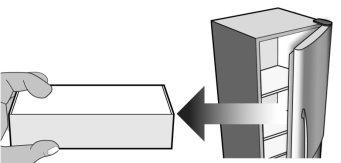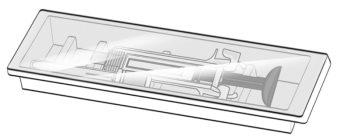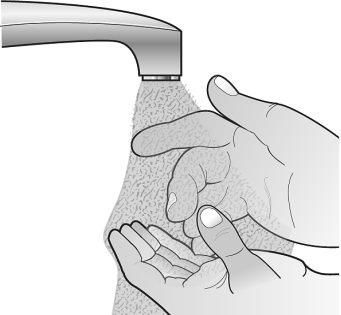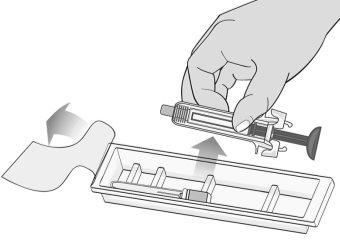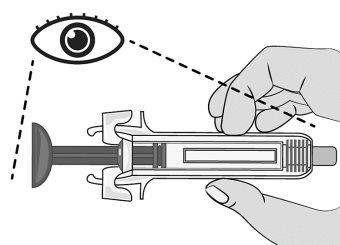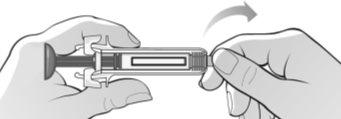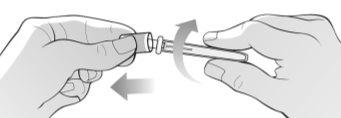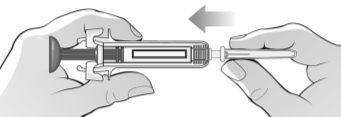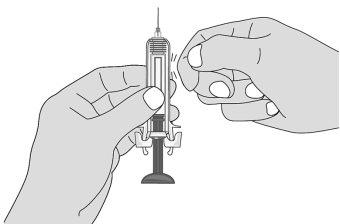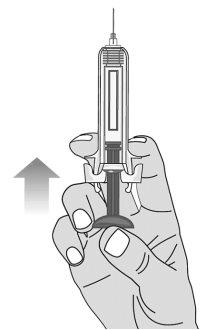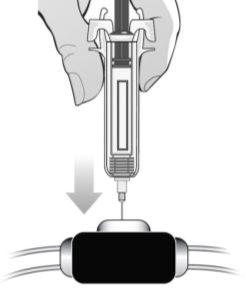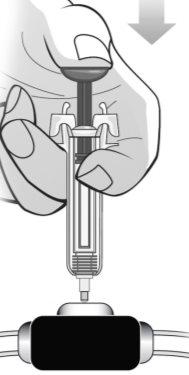
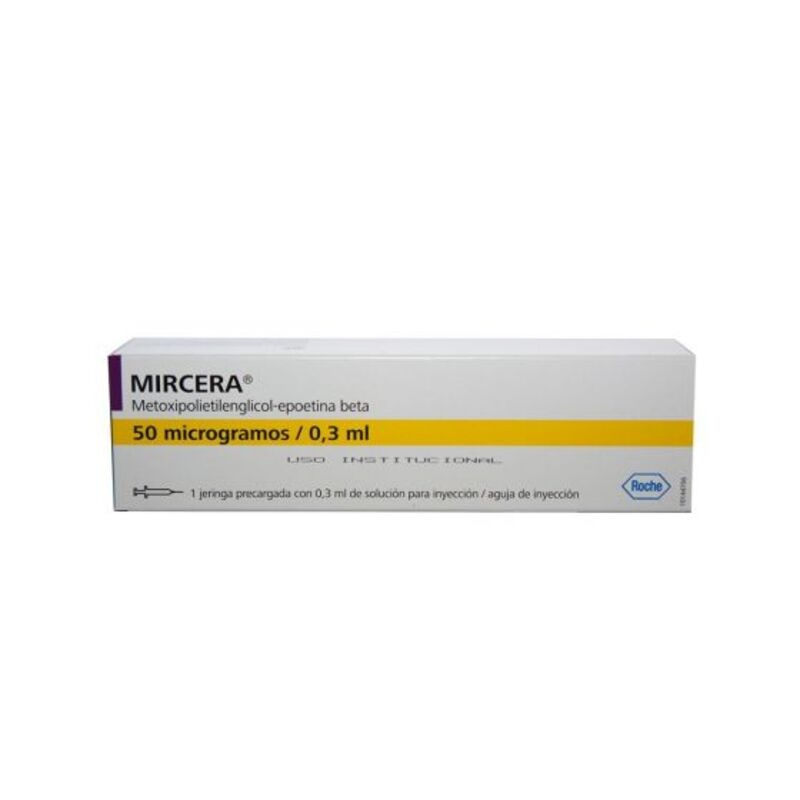
МІРЦЕРА 50 мікрограм/0,3 мл РОЗЧИН ДЛЯ ІН'ЄКЦІЙ У ПЕРЕДНАПОВНЕНИХ ШПРИЦАХ

Запитайте лікаря про рецепт на МІРЦЕРА 50 мікрограм/0,3 мл РОЗЧИН ДЛЯ ІН'ЄКЦІЙ У ПЕРЕДНАПОВНЕНИХ ШПРИЦАХ

Інструкція із застосування МІРЦЕРА 50 мікрограм/0,3 мл РОЗЧИН ДЛЯ ІН'ЄКЦІЙ У ПЕРЕДНАПОВНЕНИХ ШПРИЦАХ
Введення
Опис:інформація для користувача
MIRCERA
30мкг/0,3мл ін'єкційне розчин у попередньо наповненому шприці
50мкг/0,3мл ін'єкційне розчин у попередньо наповненому шприці
75мкг/0,3мл ін'єкційне розчин у попередньо наповненому шприці
100мкг/0,3мл ін'єкційне розчин у попередньо наповненому шприці
120мкг/0,3мл ін'єкційне розчин у попередньо наповненому шприці
150мкг/0,3мл ін'єкційне розчин у попередньо наповненому шприці
200мкг/0,3мл ін'єкційне розчин у попередньо наповненому шприці
250мкг/0,3мл ін'єкційне розчин у попередньо наповненому шприці
360мкг/0,6мл ін'єкційне розчин у попередньо наповненому шприці
метокси-поліетиленгліколь епоеціна бета
Прочитайте уважно весь листок перед тим, як почати використовувати цей лікарський засіб, оскільки він містить важливу інформацію для вас.
- Збережіть цей листок, оскільки вам може знадобитися знову його прочитати.
- Якщо у вас виникли питання, проконсультуйтеся з вашим лікарем або фармацевтом.
- Цей лікарський засіб призначений тільки вам, і не слід давати його іншим людям, навіть якщо вони мають такі самі симптоми, оскільки це може їм нашкодити.
- Якщо ви відчуваєте побічні ефекти, проконсультуйтеся з вашим лікарем, навіть якщо це побічні ефекти, які не вказані в цьому листку. Див. розділ 4.
Зміст листка:
- Що таке MIRCERA і для чого він використовується
- Що потрібно знати перед тим, як почати використовувати MIRCERA
- Як використовувати MIRCERA
- Можливі побічні ефекти
- Збереження MIRCERA
- Зміст упаковки та додаткова інформація
1. Що таке MIRCERA і для чого він використовується
Вам призначили цей лікарський засіб, оскільки ви страждаєте на анемію, викликану хронічною нирковою хворобою. Ця анемія супроводжується типовими симптомами, такими як втома, слабкість і відчуття нестачі повітря. Це означає, що в вас дуже мало червоних кров'яних тілець, і ваш рівень гемоглобіну занадто низький (можливо, тканини вашого організму не отримують достатньої кількості кисню).
MIRCERA призначений тільки для лікування симптомної анемії, викликаної хронічною нирковою хворобою, у дорослих і дітей (від 3 місяців до 18 років) під час підтримуючого лікування агентом, що стимулює еритропоез (АСЕ) після стабілізації рівня гемоглобіну попереднім АСЕ.
MIRCERA - лікарський засіб, отриманий за допомогою генної інженерії. Як і природний гормон еритропоетин, MIRCERA збільшує кількість червоних кров'яних тілець і рівень гемоглобіну в крові.
2. Що потрібно знати перед тим, як почати використовувати MIRCERA
Не використовувати MIRCERA
- якщо ви алергічні на метокси-поліетиленгліколь епоеціну бету або на будь-який інший компонент цього лікарського засобу (включно з розділом 6)
- якщо ви страждаєте на неkontrolовану гіпертонію
Попередження та обережність
Не встановлено безпеку та ефективність лікування MIRCERA в інших показаннях, включаючи анемію у пацієнтів з раком.
Безпека та ефективність лікування MIRCERA у дітей встановлені тільки у пацієнтів, рівень гемоглобіну яких попередньо стабілізувався під час лікування АСЕ.
Перед тим, як почати лікування MIRCERA
- У деяких пацієнтів, які отримували агенти, що стимулюють еритропоез (АСЕ), включаючи MIRCERA, спостерігалося захворювання, яке називається чистою еритроцитарною аплазією (ЧЕА, ануляція або зниження виробництва червоних кров'яних тілець) через наявність антитіл проти еритропоетину.
- Якщо ваш лікар підозрює або підтверджує, що у вас є ці антитіла в крові, не слід використовувати MIRCERA.
Якщо ви пацієнт з гепатитом С і приймаєте інтерферон та рибавірин, вам потрібно обговорити це з вашим лікарем, оскільки поєднання АСЕ з інтерфероном та рибавірином може призвести до втрати ефекту та в окремих випадках розвитку ЧЕА, яке є тяжкою анемією. АСЕ не затверджені для лікування анемії, пов'язаної з гепатитом С.
- Якщо ви пацієнт з хронічною нирковою хворобою та анемією, який приймає АСЕ, і також є пацієнтом з раком, вам потрібно знати, що АСЕ можуть мати негативний вплив на вашу хворобу. Вам потрібно обговорити з вашим лікарем інші варіанти лікування анемії.
- Не відомо, чи має MIRCERA інший ефект у пацієнтів з гемоглобінопатіями (розладами, пов'язаними з аномальним рівнем гемоглобіну), з кровотечами на даний момент або в минулому, з судомами або у тих, у кого високий рівень тромбоцитів у крові. Якщо у вас є одна з цих хвороб, ваш лікар обговорить це з вами та буде лікувати вас з обережністю.
- Здорові люди не повинні використовувати MIRCERA. Його використання може призвести до надто високого рівня гемоглобіну та спричинити проблеми з серцем або судинами, які можуть бути небезпечними для життя.
Під час лікування MIRCERA
- Якщо ви пацієнт з хронічною нирковою недостатністю, особливо якщо ви не реагуєте належним чином на MIRCERA, ваш лікар буде контролювати вашу дозу MIRCERA, оскільки повторне збільшення дози MIRCERA, якщо ви не реагуєте на лікування, може збільшити ризик розвитку проблем з серцем або судинами, і може збільшити ризик інфаркту міокарда, інсульту та смерті.
- Ваш лікар може почати лікування MIRCERA, якщо ваш рівень гемоглобіну нижчий або дорівнює 10 г/дл (6,21 ммоль/л). Після початку лікування ваш лікар буде підтримувати ваш рівень гемоглобіну між 10 та 12 г/дл (7,45 ммоль/л).
- Ваш лікар буде контролювати кількість заліза у вашій крові перед та під час лікування MIRCERA. Якщо кількість заліза занадто низька, ваш лікар може призначити додаткове лікування.
- Ваш лікар буде контролювати ваш тиск перед та під час лікування MIRCERA. Якщо ваш тиск високий і не може бути контролюється, ні за допомогою відповідних лікарських засобів, ні за допомогою спеціальної дієти, ваш лікар перерве ваше лікування MIRCERA або зменшить дозу.
- Ваш лікар буде контролювати, щоб ваш рівень гемоглобіну не перевищував певного значення. Високий рівень гемоглобіну може збільшити ризик розвитку серйозних проблем з серцем або судинами, що може збільшити ризик тромбозу, включаючи легеневий ембол, інфаркт міокарда, інсульт та смерті.
- Повідомте вашому лікареві, якщо ви відчуваєте втому, слабкість або відчуття нестачі повітря, оскільки це може означати, що ваше лікування MIRCERA не є ефективним. Ваш лікар буде контролювати, щоб ви не мали інших причин анемії, та може призначити аналізи крові або обстеження кісткового мозку. Якщо у вас розвинується ЧЕА, ваше лікування MIRCERA буде перервано. Ви не отримуватимете інший АСЕ, та ваш лікар буде лікувати цю хворобу.
Діти та підлітки
MIRCERA можна використовувати для лікування дітей та підлітків (від 3 місяців до 18 років) з анемією, пов'язаною з хронічною нирковою хворобою. Їх потрібно стабілізувати під час підтримуючого лікування АСЕ перед тим, як перейти на MIRCERA, та вони можуть або не можуть отримувати діаліз.
Проконсультуйтеся з вашим лікарем, фармацевтом або медсестрою перед тим, як вам буде введено цей лікарський засіб, якщо ви або ваш дитина молодші 18 років.
Будьте обережні з іншими лікарськими засобами, які стимулюють вироблення червоних кров'яних тілець:MIRCERA - один з агентів, що стимулюють вироблення червоних кров'яних тілець, як і людський білок еритропоетин. Ваш лікар завжди повинен реєструвати точний продукт, який ви використовуєте.
Спостерігалися серйозні шкірні реакції, такі як синдром Стівенса-Джонсона (ССД) та токсична епідермальна некроліз (ТЕН) при введенні епоеціну.
ССД/ТЕН може спочатку проявлятися як плями або червоні плями на шкірі, часто з пухирями в центрі на тулубі. Можуть також з'явитися виразки у роті, горлі, носі, геніталіях та очах (запалення та набухання очей). Ці серйозні шкірні реакції часто супроводжуються лихоманкою або симптомами, подібними до грипу. Шкірна реакція може прогресувати до загальної лущення шкіри та потенційно смертельних ускладнень.
Якщо ви відчуваєте серйозну шкірну реакцію або інші шкірні симптоми, припиніть приймати Mircera та негайно зверніться до вашого лікаря або пошукайте медичну допомогу.
Вживання MIRCERA з іншими лікарськими засобами
Повідомте вашому лікареві або фармацевту, якщо ви використовуєте, нещодавно використовували або можете використовувати інші лікарські засоби.
Не проводилися дослідження взаємодії. Не відомо, чи взаємодіє MIRCERA з іншими лікарськими засобами.
Вживання MIRCERAіз харчовими продуктами та напоями
Харчові продукти та напої не впливають на MIRCERA.
Вагітність, лактація та фертильність
Проконсультуйтеся з вашим лікарем або фармацевтом перед тим, як використовувати будь-який лікарський засіб.
Не проводилися дослідження MIRCERA у вагітних жінок або під час лактації.
Повідомте вашому лікареві, якщо ви вагітні, якщо ви думаєте, що можете бути вагітною, або якщо плануєте завагітніти. Ваш лікар вирішить, який лікування найкраще для вас під час вагітності.
Повідомте вашому лікареві, якщо ви перебуваєте у період лактації або плануєте це. Ваш лікар порадить вам, чи потрібно припинити або продовжувати лактацію, та чи потрібно припинити або продовжувати ваше лікування.
MIRCERA не показав жодних ознак порушення фертильності у тварин. Не відомо, який ризик потенційно існує у людей.
Відповідність транспортних засобів та використання машин
MIRCERA не впливає на вашу здатність керувати транспортними засобами та використовувати машини.
Важлива інформація про деякі компоненти MIRCERA
Цей лікарський засіб містить менше 1 ммоль (23 мг) натрію на мл; тобто, він практично не містить натрію.
3. Як використовувати MIRCERA
Слідуйте точно інструкціям щодо введення цього лікарського засобу, вказаним вашим лікарем. У разі сумнівів проконсультуйтеся з вашим лікарем або фармацевтом.
Ваш лікар буде використовувати найнижчу ефективну дозу для контролю симптомів вашої анемії.
Якщо ви не реагуєте належним чином на MIRCERA, ваш лікар буде контролювати вашу дозу та повідомить вам, чи потрібно змінити дозу MIRCERA.
Лікування MIRCERA повинно бути розпочато під наглядом лікаря. Наступні ін'єкції можна вводити лікарем або, після того, як вам покажуть, як це зробити, дорослий пацієнт може самостійно вводити MIRCERA. Діти та підлітки молодші 18 років не повинні самостійно вводити MIRCERA; введення повинно проводитися лікарем або кваліфікованим медичним працівником. (слідувати інструкціям наприкінці листка щодо використання попередньо наповненого шприца MIRCERA для самостійного введення ін'єкції).
MIRCERA можна вводити під шкіру в живіт, руку або стегно або в вену. Ваш лікар вирішить, що найкраще для вас.
Ваш лікар буде проводити регулярні аналізи крові та контролювати, як ваша анемія реагує на лікування.
- Якщо ви дорослий пацієнт, який не приймає АСЕ на даний момент
- Якщо ви не перебуваєте на діалізі, рекомендується початкова доза MIRCERA 1,2 мкг на кг ваги, вводиться один раз на місяць у вигляді однієї ін'єкції під шкіру. Альтернативно, ваш лікар може вирішити призначити початкову дозу MIRCERA 0,6 мкг на кг ваги. Доза вводиться один раз на два тижні під шкіру або в вену. Після того, як анемія буде виправлена, ваш лікар може змінити режим введення на один раз на місяць.
- Якщо ви перебуваєте на діалізі, рекомендується початкова доза 0,6 мкг на кг ваги. Доза вводиться один раз на два тижні у вигляді однієї ін'єкції під шкіру або в вену. Після того, як анемія буде виправлена, ваш лікар може змінити режим введення на один раз на місяць.
Ваш лікар може збільшити або зменшити вашу дозу чи тимчасово припинити ваше лікування, щоб调整 ваш рівень гемоглобіну до відповідного для вас рівня. Зміни дози не проводяться частіше одного разу на місяць.
- Якщо ви приймаєте інший АСЕ на даний момент
Ваш лікар може замінити ваш поточний лікарський засіб на MIRCERA. Ваш лікар вирішить, чи потрібно лікувати вас MIRCERA, вводячи його один раз на місяць. Ваш лікар розрахує вашу початкову дозу MIRCERA на основі останньої дози вашого попереднього лікарського засобу. Перша доза MIRCERA вводиться в день, коли було призначено введення вашого попереднього лікарського засобу.
Ваш лікар може збільшити або зменшити вашу дозу чи тимчасово припинити ваше лікування, щоб调整 ваш рівень гемоглобіну до відповідного для вас рівня. Зміни дози не проводяться частіше одного разу на місяць.
Якщо ви прийняли більше MIRCERA, ніж потрібно
Повідомте вашому лікареві або фармацевту, якщо ви прийняли занадто велику дозу MIRCERA, оскільки можуть знадобитися аналізи крові та припинення вашого лікування.
Якщо ви забули прийняти MIRCERA
Якщо ви забули прийняти дозу MIRCERA, введіть дозу як тільки вам нагадаєте, та запитайте вашого лікаря, коли вводити наступні дози.
Якщо ви припинили лікування MIRCERA
Лікування MIRCERA зазвичай тривале. Однак його можна припинити в будь-який момент, якщо це вказано вашим лікарем.
Якщо у вас є будь-які інші питання щодо використання цього лікарського засобу, запитайте вашого лікаря або фармацевта.
4. Можливі побічні ефекти
Як і всі лікарські засоби, цей лікарський засіб може спричиняти побічні ефекти, хоча не всі люди їх відчувають.
Частота можливих побічних ефектів наведена нижче:
Частий побічний ефект (може впливати до 1 з 10 пацієнтів) - гіпертонія (високий тиск).
Рідкісні побічні ефекти (може впливати до 1 з 100 пацієнтів) - це:
- головний біль
- тромбоз у зоні доступу до судини (згустки крові в місці доступу до діалізу) тромбоцитопенія
- тромбоз
Рідкісні побічні ефекти (може впливати до 1 з 1000 пацієнтів) - це:
- гіпертензивна енцефалопатія (дуже високий тиск, який може спричинити головний біль, особливо мігренеподібний, раптовий і колючий, сплутаність, порушення мови, судоми або конвульсії).
- легеневий ембол
- ерупція макуло-папулярна (червоні плями на шкірі, які можуть включати гранули або прyszczki)
- червоність з жаром
- гіперчутливість (алергічна реакція, яка може спричинити незвичайні звуки при диханні або труднощі з диханням, запалення мови, обличчя або горла або набухання навколо місця ін'єкції або зробити вас дезорієнтованим, викликати падіння або спричинити падіння).
Якщо ви відчуваєте ці симптоми, негайно повідомте вашому лікареві, щоб отримати лікування.
Під час клінічних досліджень пацієнти мали незначне зниження кількості тромбоцитів у крові. Зареєстровані випадки зниження кількості тромбоцитів нижче нормального рівня (тромбоцитопенія) у період після виходу лікарського засобу на ринок.
Спостерігалися реакції гіперчутливості, включаючи випадки анафілактичної реакції та серйозних шкірних реакцій, таких як синдром Стівенса-Джонсона (ССД) та токсична епідермальна некроліз (ТЕН), при введенні епоеціну. Ці реакції можуть проявлятися як плями або червоні плями на шкірі, часто з пухирями в центрі на тулубі, лущення шкіри та виразки у роті, горлі, носі, геніталіях та очах, та можуть бути попереджені лихоманкою та симптомами, подібними до грипу. Припиніть приймати Mircera, якщо ви відчуваєте ці симптоми, та негайно зверніться до вашого лікаря або пошукайте медичну допомогу. Див. також розділ 2.
Як і з іншими АСЕ, у період після виходу лікарського засобу на ринок зареєстровані випадки тромбозу, включаючи легеневий ембол.
У деяких пацієнтів, які приймають АСЕ, включаючи MIRCERA, спостерігалося захворювання, яке називається чистою еритроцитарною аплазією (ЧЕА, ануляція або зниження виробництва червоних кров'яних тілець) через наявність антитіл проти еритропоетину.
Звіт про побічні ефекти
Якщо ви відчуваєте будь-який побічний ефект, повідомте вашому лікареві або фармацевту, навіть якщо це побічні ефекти, які не вказані в цьому листку. Ви також можете повідомити про них безпосередньо через національну систему повідомлень, вказану в додатку V. Повідомляючи про побічні ефекти, ви можете допомогти надати більше інформації про безпеку цього лікарського засобу.
5. Збереження MIRCERA
Тримайте цей лікарський засіб поза зоною досяжності дітей.
Не використовувати MIRCERA після закінчення терміну придатності, вказаного на картоні та на етикетці шприца після "EXP". Термін придатності - останній день місяця, який вказано.
Зберігайте у холодильнику (між 2 °C - 8 °C). Не заморожуйте.
Зберігайте шприц у зовнішній упаковці, щоб захистити його від світла.
Ви можете вийняти шприц MIRCERA з холодильника та зберігати його при кімнатній температурі, ніколи не вище 30 °C, протягом одного місяця. Під час цього періоду, коли ви зберігали MIRCERA при кімнатній температурі, ніколи не вище 30 °C, ви не можете знову повернути MIRCERA до холодильника перед його використанням. Після того, як ви виймете лікарський засіб з холодильника, ви повинні використовувати його протягом цього місяця.
Вводьте тільки прозорі розчини, безбарвні або легенько жовтуваті, які не містять видимих частинок.
Лікарські засоби не слід викидати у водопровід або сміття.
Запитайте вашого фармацевта, як позбутися упаковок та лікарських засобів, які вам більше не потрібні. Це допоможе захистити навколишнє середовище.
6. Зміст упаковки та додаткова інформація
Склад МІРСЕРА
- Активна речовина - метоксиполіетиленгліколь епоетин бета. Передplněна шприц містить: 30, 50, 75, 100, 120, 150, 200 або 250 мкг у 0,3 мл і 360 мкг у 0,6 мл.
- Інші компоненти - моногідрат моносодійного фосфату, сульфат натрію, манітол (Е421), метіонін, полоксамер 188 та вода для ін'єкційних препаратів.
Вигляд продукту та вміст упаковки
МІРСЕРА - ін'єкційний розчин у передplněному шприці.
Прозорий розчин без кольору або з легким жовтим відтінком і без видимих частинок.
МІРСЕРА випускається у передplněних шприцах з ламінованим поршнем і захисником з голкою 27 Г1/2. Кожен передplněний шприц містить 0,3 мл або 0,6 мл розчину. Передplněні шприци не призначені для введення часткових доз. МІРСЕРА доступна для всіх доз у упаковках по 1 та також у упаковках по 3 для доз 30, 50, 75 мкг/0,3 мл. Можливо, що тільки деякі розміри упаковок будуть реалізовані.
Уповноважений на реєстрацію та відповідальний за виробництво
Roche Registration GmbH
Emil-Barell-Strasse 1
79639 Grenzach-Wyhlen
Німеччина
Виробник
Roche Pharma AG
Emil-Barell-Strasse 1
79639 Grenzach-Wyhlen
Німеччина
Для отримання додаткової інформації щодо цього лікарського засобу зверніться до місцевого представника уповноваженого на реєстрацію:
|
Чеська Республіка Roche s. r. o. Тел: +420 - 2 20382111 | Угорщина Roche (Угорщина) Кфт. Тел: +36 - 1 279 4500 |
Данія Roche Pharmaceuticals А/С Телефон: +45 - 36 39 99 99 | Мальта (Див. Ірландію) |
Німеччина Roche Pharma AG Тел: +49 (0) 7624 140 | Нідерланди Roche Nederland Б.В. Тел: +31 (0) 348 438050 |
Естонія Roche Естонія ОУ Тел: + 372 - 6 177 380 | Норвегія Roche Норвегія АС Телефон: +47 - 22 78 90 00 |
Греція Roche (Греція) А.Е. Телефон: +30 210 61 66 100 | Австрія Roche Австрія ГмбХ Тел: +43 (0) 1 27739 |
Іспанія Roche Фарма С.А. Тел: +34 - 91 324 81 00 | Польща Roche Польща Сп. з о.о. Тел: +48 - 22 345 18 88 |
Франція Roche Телефон: +33 (0)1 47 61 40 00 | Португалія Roche Фармацевтична Квіміка, Лда Тел: +351 - 21 425 70 00 |
Хорватія Roche д.о.о. Тел: + 385 1 47 22 333 | Румунія Roche Румунія С.Р.Л. Тел: +40 21 206 47 01 |
Ірландія Roche Продукти (Ірландія) Лтд. Тел: +353 (0) 1 469 0700 | Словенія Roche фармацевтична дружба д.о.о. Тел: +386 - 1 360 26 00 |
Ісландія Roche Фармацевтичні А/С за адресою Icepharma hf Телефон: +354 540 8000 | Словаччина Roche Словаччина, с.р.о. Тел: +421 - 2 52638201 |
Італія Roche С.п.А. Тел: +39 - 039 2471 | Фінляндія Roche Ой Телефон/Тел: +358 (0) 10 554 500 |
Кіпр Г.А.Стаматіс та Сія Лтд. Телефон: +357 - 22 76 62 76 | Швеція Roche АБ Тел: +46 (0) 8 726 1200 |
Латвія Roche Латвія СІА Тел: +371 - 6 7039831 | Велика Британія(Північна Ірландія) Roche Продукти (Ірландія) Лтд. Тел: +44 (0) 1707 366000 |
Дата останнього перегляду цього посібника:
Детальна інформація про цей лікарський засіб доступна на сайті Європейського агентства з лікарських засобів http://www.ema.europa.eu/.
МІРСЕРА передplněний шприц Інструкції з використання |
Наступні інструкції пояснюють, як використовувати МІРСЕРА передplněні шприци, щоб ви самі або інша особа могли зробити ін'єкцію. Важливо, щоб ви прочитали та дотримувалися цих інструкцій, щоб ви могли використовувати передplněний шприц правильно та безпечно. Ненамагайтесь зробити ін'єкцію, поки не будете впевнені, що зрозуміли, як використовувати передplněний шприц. У разі сумнівів зверніться до медичного спеціаліста. Діти та підлітки молодші 18 років не повинніробити ін'єкції МІРСЕРА самостійно; введення лікарського засобу повинно здійснюватися медичним спеціалістом або дорослим опікуном, який пройшов відповідну підготовку. Завжди дотримуйтесь інструкцій, оскільки вони можуть відрізнятися від вашого досвіду. Ці інструкції допоможуть вам запобігти неправильному лікуванню або ризикам, таким як травми від голок або передчасна активація пристрою безпеки голки, або проблем, пов'язаних із розміщенням голки. |
ВІДОМА ІНФОРМАЦІЯ
• Використовуйте тільки МІРСЕРА передplněний шприц, якщо вам призначений цей лікарський засіб.
• Перевірте упаковку та переконайтесь, що у вас є призначена лікарем доза.
• Не використовуватиМІРСЕРА, якщо шприц, голка, коробка або пластикова підкладка, що містить шприц, здаються пошкодженими.
- Голка хрупка, обережно з нею.
• Не торкайтесязахисних ковпачків (див. Фігуру А), оскільки це може пошкодити шприц та зробити його непридатним для використання.
• Не використовуватишприц, якщо вміст є мутним, білуватим або містить частинки.
• Ніколине намагайтесь розібрати шприц.
• Ніколине викидаєте та не маніпулюйте шприцем за допомогою поршня.
• Не знімайтезахисний ковпачок з голки, поки ви не будете готові зробити ін'єкцію.
• Не приймайтелікарський засіб з шприца всередину.
• Не вводьтейого через одяг.
• Неповторно використовуйте та не стерилізуйте шприц чи голку.
• Передplněні шприци не призначені для введення часткових доз.
• Тримайте шприц, голку та медичні матеріали поза досяжністю дітей.
ЗБОВІЖЕННЯ
Тримайте передplněний шприц, голку таконтейнер для видалення колючих/різаних предметівпоза досяжністю дітей.
Зберігайте шприц та голку в оригінальній упаковці до моменту використання.
Завжди тримайте шприц та голку в холодильнику при температурі від 2 до 8 °C (35,6 - 46,4 °F).
Недозволяйте лікарському засобу замерзати та захищайте його від світла. Тримайте шприц та голку в сухому місці.
МАТЕРІАЛИ, ВКЛЮЧЕНІ У УПАКОВКУ (Фігура А):
- Передplněний шприц, що містить МІРСЕРА
- Голка для ін'єкції

Фігура А
МАТЕРІАЛИ, НЕ ВКЛЮЧЕНІ У УПАКОВКУ (Фігура Б):
Ватні диски з спиртом | Стерильна вата або газа | Контейнери для видалення колючих та різаних предметів для безпечного видалення використаних голок та шприців |

Фігура Б
Помістіть всі необхідні матеріали для ін'єкції на плоскій, чистій та добре освітленій поверхні, наприклад, на стіл.
ЯК ВИКОНАТИ ІН'ЄКЦІЮ | |
Крок 1: Дайте шприцу досягти кімнатної температури | |
Фігура С | Обережно вийміть з холодильника упаковку МІРСЕРА передplněного шприца. Тримайте шприц та голку всередині упаковки, захищені від світла, та дайте їм досягти кімнатної температури протягом щонайменше 30 хвилин (Фігура С). • Якщо лікарський засіб не досягне кімнатної температури, ін'єкція може бути незручною та ускладнить натискання на поршень. • Не нагрівайтешприц якимось іншим способом. |
Фігура Д | Відкрийте коробку та вийміть з упаковки пластикову підкладку МІРСЕРА передplněного шприца без зняття захисної плівки (Фігура Д). |
Крок 2: Вимийте руки | |||||
| |||||
Фігура Г | Перевірте шприц на наявність пошкоджень та перевірте термін придатності, вказаний на шприці та в упаковці. Це важливо для забезпечення безпеки шприца та лікарського засобу для використання (Фігура Г). Невикористовуйте шприц, якщо: • Випадково він впав. • Якась частина шприца здається пошкодженою. • Вміст є мутним, білуватим або містить частинки.
• Термін придатності закінчився. |
Крок 4: Закріпіть голку на шприці
Фігура Х | Тримайте шприц міцно за середину та гумову кришку на кінці та зніміть кришку (зігніть та потягніть) (Фігура Х).
• Не торкайтесязахисних ковпачків. • Не натискайтена поршень. • Не тягнітьза поршень. |
Фігура І | Тримайте упаковану голку міцно обома руками та перевірте, чи не пошкоджена голка. Зігніть та зніміть захисний ковпачок голки, використовуючи обертальний рух, як показано на ілюстрації (Фігура І). Відразу викиньте захисний ковпачок голки у контейнер для видалення колючих предметів. Не знімайтезахисний ковпачок голки, який виконує цю функцію. Не використовуйте голку, якщо:
|
Фігура Й | Закріпіть голку на шприці, натиснувши її міцно та обернувши або повернувши її трохи (Фігура Й). |
Крок 5: Зніміть захисний ковпачок шприца та підготуйтеся до ін'єкції | |
Фігура К | Тримайте шприц міцно однією рукою за середину корпусу та потягніть за захисний ковпачок шприца іншою рукою. Викиньте захисний ковпачок шприца у контейнер для видалення колючих предметів (Фігура К).
|
Фігура Л | Щоб видалити повітряні бульбашки з шприца, тримайте шприц з голкою, спрямованою вгору. Легко стукніть по шприцу, щоб бульбашки піднялися (Фігури Л та М). |
Фігура М | Натисніть на поршень повільно, щоб видалити весь повітряний простір, як вам показав медичний спеціаліст (Фігура М). |
Крок 6: Виконайте ін'єкцію Існує два різні способи введення МІРСЕРА в організм. Дотримуйтесь рекомендацій медичного спеціаліста щодо того, як вводити МІРСЕРА. | |
Підшкірний шлях: Якщо вам порадили вводити МІРСЕРА під шкіру, введіть дозу так, як описано нижче. | |
Фігура Н | Виберіть одне з рекомендованих місць для ін'єкції. Ви можете вводити МІРСЕРА в верхню частину руки, стегно або живіт, крім ділянки навколо пупка (Фігура Н). Задня частина верхньої частини руки не є рекомендованим місцем для самостійної ін'єкції. Використовуйте цю зону ін'єкції лише якщо ви вводите лікарський засіб іншій особі. При виборі місця ін'єкції: • Виберіть місце ін'єкції, яке відрізняється від попереднього місця ін'єкції至少 на 3 см. • Невводіть ін'єкцію в місця, які можуть бути пошкоджені поясом або краєм одягу. • Невводіть ін'єкцію в місця з родимками, шрамами, синяками або ділянками шкіри, які є чутливими, червоними, твердими чи пошкодженими. |
Фігура О | Очистіть місце ін'єкції ватним диском з спиртом, щоб зменшити ризик інфекції; дотримуйтесь інструкцій ватного диска з спиртом (Фігура О). • Дайте шкірі висохнути протягом приблизно 10 секунд. • Переконайтесь, що не торкнулисячистої ділянки шкіри перед ін'єкцією та не дмухайте на неї. • Відразу викиньте ватний диск з спиртом. |
Фігура П
Фігура К | Займіть зручну позицію перед тим, як зробити ін'єкцію МІРСЕРА. Щоб забезпечити правильне введення голки в шкіру, зігніть шкіру в місці ін'єкції вільною рукою. Це важливо для забезпечення того, щоб ін'єкція проводилася під шкіру (у жирову тканину), а не глибше (у м'язи). Якщо ін'єкція проводиться в м'язи, це може бути незручним (Фігура П). Обережно введіть голку повністю в шкіру під кутом 90°, виконуючи швидкий рух, як при викиданні дротика. Потім тримайте шприц на місці та припиніть зігинати шкіру. Нерухайте голку, поки вона введена в шкіру. Після того, як голка буде повністю введена в шкіру, натисніть на поршень повільно великим пальцем та проти тримачів, поки не буде введено весь лікарський засіб, тримаючи шприц пальцями та середнім пальцем. Поршень повинен бути повністю внизу (натиснутий), і ви повинні почути «клік», який вказує на активацію пристрою безпеки голки (Фігура К). |
| Невипускайте поршень до закінчення ін'єкції або до повного натискання на поршень (Фігура Р). |
Фігура Р
Фігура С | Випустіть поршень, дозволяючи пристрою безпеки голки шприца захистити голку (Фігура С). |
|
Шприц, завантажений з відтягнутим поршнем, показуючи захисник голки та прозорий циліндр з лікарським засобом"> Фігура Т | Тепер ви можете зняти стікер, якщо це необхідно (Фігура Т). | |||
Після ін'єкції: ? Помістіть ватний тампон або стерильну марлю на місце ін'єкції та натисніть на кілька секунд. ? Відразу викиньте ватний тампон або марлю після використання. ? Нетертіть місце ін'єкції брудною рукою чи тьормою. ? Якщо необхідно, можна накрити місце ін'єкції маленьким пластирем. Викиньте шприц: ? Неспробуйте знову поставити захисник на голку. ? Неповторно використовуйте чи стерилізуйте шприц та/або голку. ? Невикиньте використаний шприц з голкою у домашнє сміття. ? Викиньте використані шприци у контейнер для видалення колючих/різаних предметів та/або згідно з нормативами органів охорони здоров'я. ? Викиньте повний контейнер для видалення колючих/різаних предметів. ІНТРАВЕНОЗНО: Якщо медичний працівник порадив вам вводити МІРЦЕРУ в вену, слідуйте описаному нижче процесу. Після підготовки шприца згідно з описом кроків 1-5: Очистіть венозний порт гемодіалізного трубопроводу ватним тампоном з алкоголем, як вказано постачальником або виробником. Відразу викиньте ватний тампон з алкоголем після використання.
Крок 7: Викиньте шприц з голкою | ||||
| ||||
- Країна реєстрації
- Діючі речовини
- Потрібен рецептТак
- Виробник
- Інформація є довідковою і не є медичною порадою. Перед прийомом будь-яких препаратів обов'язково проконсультуйтеся з лікарем. Oladoctor не несе відповідальності за медичні рішення, прийняті на основі цього контенту.
- Альтернативи до МІРЦЕРА 50 мікрограм/0,3 мл РОЗЧИН ДЛЯ ІН'ЄКЦІЙ У ПЕРЕДНАПОВНЕНИХ ШПРИЦАХФорма випуску: РОЗЧИН ДЛЯ ІН'ЄКЦІЙ, 100 мкгДіючі речовини: methoxy polyethylene glycol-epoetin betaВиробник: Roche Registration GmbhПотрібен рецептФорма випуску: РОЗЧИН ДЛЯ ІН'ЄКЦІЙ, 120 мкгДіючі речовини: methoxy polyethylene glycol-epoetin betaВиробник: Roche Registration GmbhПотрібен рецептФорма випуску: РОЗЧИН ДЛЯ ІН'ЄКЦІЙ, 150 мкгДіючі речовини: methoxy polyethylene glycol-epoetin betaВиробник: Roche Registration GmbhПотрібен рецепт
Аналоги МІРЦЕРА 50 мікрограм/0,3 мл РОЗЧИН ДЛЯ ІН'ЄКЦІЙ У ПЕРЕДНАПОВНЕНИХ ШПРИЦАХ в інших країнах
Найкращі аналоги з тією самою діючою речовиною та терапевтичним ефектом.
Аналог МІРЦЕРА 50 мікрограм/0,3 мл РОЗЧИН ДЛЯ ІН'ЄКЦІЙ У ПЕРЕДНАПОВНЕНИХ ШПРИЦАХ у Ukraina
Лікарі онлайн щодо МІРЦЕРА 50 мікрограм/0,3 мл РОЗЧИН ДЛЯ ІН'ЄКЦІЙ У ПЕРЕДНАПОВНЕНИХ ШПРИЦАХ
Консультація щодо дозування, побічних ефектів, взаємодій, протипоказань та поновлення рецепта на МІРЦЕРА 50 мікрограм/0,3 мл РОЗЧИН ДЛЯ ІН'ЄКЦІЙ У ПЕРЕДНАПОВНЕНИХ ШПРИЦАХ – за рішенням лікаря та згідно з місцевими правилами.





